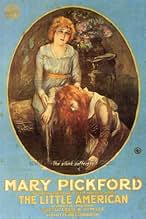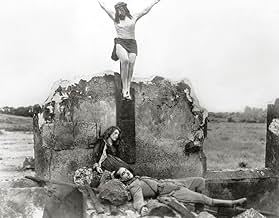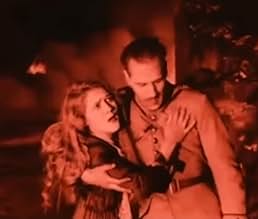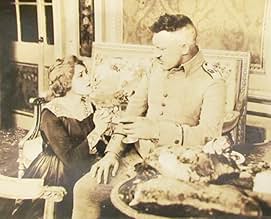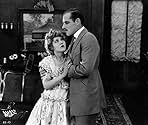अपनी भाषा में प्लॉट जोड़ेंA young American has her ship torpedoed by a German U-boat but makes it back to ancestral home in France, where she witnesses German brutality firsthand.A young American has her ship torpedoed by a German U-boat but makes it back to ancestral home in France, where she witnesses German brutality firsthand.A young American has her ship torpedoed by a German U-boat but makes it back to ancestral home in France, where she witnesses German brutality firsthand.
Wallace Beery
- German Soldier
- (बिना क्रेडिट के)
Olive Corbett
- Nurse
- (बिना क्रेडिट के)
Lucile Dorrington
- Nurse
- (बिना क्रेडिट के)
Clarence Geldert
- Submarine Commander U-Boat 21
- (बिना क्रेडिट के)
Carl Gerard
- Reverend
- (बिना क्रेडिट के)
Robert Gordon
- Wounded Soldier
- (बिना क्रेडिट के)
Gordon Griffith
- Child
- (बिना क्रेडिट के)
फ़ीचर्ड समीक्षाएं
With the Great War ravaging Europe as this film was made, it's a clear signal of patriotism from star Mary Pickford as she depicts the feisty "Angela". She's from wealthy stock and on her birthday is being courted by French "Count Jules" (Raymond Hatton) and by her slight favourite, the Prussian soldier "Karl" (Jack Holt). Before she has to make any choices, though, both head to their respective homes to fight. Shortly thereafter, she decides to travel to her aunt's home in France only for her liner to be torpedoed and for her to find that when she eventually arrives at her stately pile that the Bosch are intent on billeting there and behaving abominably too. Her American status gives her a degree of protection so long as she stays out of the conflict, and her stiff-necked friend "Karl" is amongst the occupiers, but when their cruelty to the house's staff and to an elderly gent shock her to the core, she decides that she can no longer stay on the fence. What now ensues sees her bravely attempt to help the Allied forces at great peril not just to her, but to her friend who would try to keep her as alive as his upbringing would permit! That merely invites a trial for espionage and treason and a firing squad for both of them looms... Can they find a way to escape the bullets? This is an effective propaganda tool, this film, illustrating just how ghastly the enemy were; how indiscriminate their violence was inflicted and how generally boorish and superior they were. Pickford and Cecil B. DeMille clearly wanted to ram that point home to domestic audiences and on that front they are quite effective. It really could have done with some more light, but even dingy as it is it delivers quite a potent analysis of uniformed thuggery tempered by conflicted romance and a semblance of human decency. It has it's zealous moments - from all sides, and in it's way it is quite a tough film to watch as though not graphic in terms of photography, it is in terms of psychology. It has a clear message to send and is worth a watch, I'd say.
THE LITTLE AMERICAN was the second of two movies Mary Pickford and Cecil B De Mille made together in 1917. These would be the only films they would collaborate on. While they were successful at the box office, Pickford and De Mille constantly clashed over who was in charge. At that time, Mary Pickford was better known than De Mille and made far more money. For economic reasons, Paramount sided with De Mille and Pickford had no choice but to go along. You would never guess this from seeing the movie.
At that point in his career, De Mille was still finding his way. TLA was one of his first big spectacles and it shows he already had the knowledge to handle large forces. Mary had just finished THE POOR LITTLE RICH GIRL which would typecast her for the rest of her career as the "little girl" character. Mary was 25 when she made her 2 De Mille pictures and it's something of a rarity to see her playing characters her actual age. When LITTLE AMERICAN started shooting, the U. S. was still neutral but entered into World War I before it was finished.
Mary plays a young American woman with 2 suitors. One is a French American, the other is a German American. This is July 1914. A month later when the war breaks out, each suitor goes to fight for his respective country. Mary inherits a chateau in France and arrives just in time to have it invaded by German troops including her German suitor. Her French suitor supervises a counter attack. The chateau is bombarded and Mary and her German suitor, who deserts, flee onto the battlefield and hide out in a church. Of course, Mary is rescued, but what about her boyfriend?
The print used for this restoration is a 35 mm copy from De Mille's original private print and in very good condition with proper color tints, original title cards,. The restoration was done by the UCLA Film & Television Archives under the auspices of the Mary Pickford Foundation. The accompanying score by Adam Chavez was newly composed for this release. This official home video release from VCI is coupled with the 1912 Biograph short, A LODGING FOR THE NIGHT and an informational booklet...For more reviews visit The Capsule Critic.
At that point in his career, De Mille was still finding his way. TLA was one of his first big spectacles and it shows he already had the knowledge to handle large forces. Mary had just finished THE POOR LITTLE RICH GIRL which would typecast her for the rest of her career as the "little girl" character. Mary was 25 when she made her 2 De Mille pictures and it's something of a rarity to see her playing characters her actual age. When LITTLE AMERICAN started shooting, the U. S. was still neutral but entered into World War I before it was finished.
Mary plays a young American woman with 2 suitors. One is a French American, the other is a German American. This is July 1914. A month later when the war breaks out, each suitor goes to fight for his respective country. Mary inherits a chateau in France and arrives just in time to have it invaded by German troops including her German suitor. Her French suitor supervises a counter attack. The chateau is bombarded and Mary and her German suitor, who deserts, flee onto the battlefield and hide out in a church. Of course, Mary is rescued, but what about her boyfriend?
The print used for this restoration is a 35 mm copy from De Mille's original private print and in very good condition with proper color tints, original title cards,. The restoration was done by the UCLA Film & Television Archives under the auspices of the Mary Pickford Foundation. The accompanying score by Adam Chavez was newly composed for this release. This official home video release from VCI is coupled with the 1912 Biograph short, A LODGING FOR THE NIGHT and an informational booklet...For more reviews visit The Capsule Critic.
With the US having recently entered the First World War, the country's best known and most popular director teamed with its most beloved actress to fire a cinematic salvo in this flag-waving adventure.
In style this is something of a departure for DeMille. He more or less abandons his use of long takes, painterly shot compositions and predominantly visual narrative, in favour of rapid editing and lots of expository intertitles. Of course this is purely pragmatic it keeps the story moving along quickly and injects some excitement and tension into what is after all a propaganda piece. The heavier than usual use of intertitles also leaves no ambiguity about plot or character intention. Some of these editing patterns are quite effective for example, the crosscutting used when the ocean liner is torpedoed. However fans of DeMille's early silents will probably find themselves missing the more considered approach they will be familiar with. This is certainly one of his least graceful films.
The fact that The Little American is more action-centred means it is less acting centred there is not the same concentration on performance that you normally get with DeMille. For this reason this is not a particularly memorable role for Mary Pickford, and to be fair almost any actress could have played the part equally well. However the casting of Pickford would have been symbolic and psychologically effective at the time. Although the press had not yet labelled her America's sweetheart, she certainly occupied that position. Therefore DeMille did not have to go out of his way to endear the audience to the character of Angela Moore, because they had already formed an emotional attachment to Mary Pickford.
Regardless of how effective this picture was in its day it is really quite a mediocre effort when taken out of context. One interesting point though the one scene in The Little American that really looks like the typical DeMille is the one in which Pickford and Holt take refuge in a ruined church below the effigy of Christ on the cross. Throughout the picture the stars and stripes is treated with the same reverence and significance DeMille might give to a crucifix. This picture is another small step towards the iconic imagery and preachiness that would characterise his work from the twenties onwards.
In style this is something of a departure for DeMille. He more or less abandons his use of long takes, painterly shot compositions and predominantly visual narrative, in favour of rapid editing and lots of expository intertitles. Of course this is purely pragmatic it keeps the story moving along quickly and injects some excitement and tension into what is after all a propaganda piece. The heavier than usual use of intertitles also leaves no ambiguity about plot or character intention. Some of these editing patterns are quite effective for example, the crosscutting used when the ocean liner is torpedoed. However fans of DeMille's early silents will probably find themselves missing the more considered approach they will be familiar with. This is certainly one of his least graceful films.
The fact that The Little American is more action-centred means it is less acting centred there is not the same concentration on performance that you normally get with DeMille. For this reason this is not a particularly memorable role for Mary Pickford, and to be fair almost any actress could have played the part equally well. However the casting of Pickford would have been symbolic and psychologically effective at the time. Although the press had not yet labelled her America's sweetheart, she certainly occupied that position. Therefore DeMille did not have to go out of his way to endear the audience to the character of Angela Moore, because they had already formed an emotional attachment to Mary Pickford.
Regardless of how effective this picture was in its day it is really quite a mediocre effort when taken out of context. One interesting point though the one scene in The Little American that really looks like the typical DeMille is the one in which Pickford and Holt take refuge in a ruined church below the effigy of Christ on the cross. Throughout the picture the stars and stripes is treated with the same reverence and significance DeMille might give to a crucifix. This picture is another small step towards the iconic imagery and preachiness that would characterise his work from the twenties onwards.
America entered World War One in April 1917 after almost three years of brutal fighting between England, France and their allies and Germany and its alliance. The first Hollywood so-called propaganda film released soon after Congress declared war on Germany and the Central Powers was Cecil B. DeMille's July 1917 "The Little American," starring Mary Pickford.
Its director DeMille had lost a good friend in the sinking of the Lusitania by a German submarine two years earlier, while Canadian Pickford had seen her native country involved in the war since 1914. Both were ardent supporters of the United States' war effort, and both eagerly participated in a movie that painted the Germans simply as barbarians. The Chicago Board of Censors, in fact, was so concerned about the city's large German-American population that it banned the movie from being shown. Two court rulings eventually overturned the censor board's prohibition from exhibiting "The Little American."
The Jeanne McPherson script does soften the anti-German edges somewhat by creating a young German residing in America as a paramour to Pickford. Karl Von Austreim, played by Jack Holt, is summoned by Germany in the fall of 1914 to join his regiment in Europe. The two lovers depart, only to once again meet on the battlefields of the Western Front. She's seen nursing several injured French soldiers after visiting her aunt in France, who had just died of natural causes near the fighting. Pickford ends up becoming a spy for the French, pinpointing important German artillery on her aunt's property. It is there she meets her old boyfriend, and he ends up becoming a protector for her.
While the film is praised for its recreation of a British liner's sinking by German hands, of which Pickford's character was a passenger, the movie failed to garner the enormous profits for the Mary Pickford Company, through its distribution branch Aircraft Pictures. This is the second and final picture DeMille directed with the popular actress. The first, released a couple months before in "A Romance of the Redwoods," was studio head Adolph Zukor's solution for a career correction for Pickford after viewing the preview of her last film, "The Poor Little Rich Girl." He saw the movie as being a total dud. Despite the actress having a clause in her contract giving her total control over her productions, Zukor felt DeMille's steady, serious hand would straighten her out. Of course "The Poor Little Rich Girl" ended up an enormous hit, and she would revert back to playing a kid again in her next two movies after "The Little American." To be fair, "Redwoods," on the basis of Pickford's star power, became the fourth highest grossing movie of the year.
Meanwhile, the two movies with DeMille spelled doom for her ongoing, unhappy marriage to actor Owen Moore, as well as making it easier in her clandestine romance with Douglas Fairbanks, whom she had met two years earlier at a Tarrytown, N. Y. party. The filming locations of "Redwoods" and "American" took place in southern California, where the married Fairbanks resided. Pickford had been living near her studio in Ft. Lee, N. J. before relocating out West. She would never live in the East ever again.
Returning to "A Little American:" Even a MacPherson script, co-written by DeMille, couldn't quite rescue "A Little American." MacPherson and the director formed one of the more successful and influential working partnerships in Hollywood. As an actress as well as a minor director and scriptwriter, she approached DeMille for an acting job in 1914. Instead, the director, realizing her scenario talents, hired her as a screenwriter. She went on to write 30 of DeMille's first 34 movie scripts, with her last screenplay for the director in 1930's "Madam Satan."
Its director DeMille had lost a good friend in the sinking of the Lusitania by a German submarine two years earlier, while Canadian Pickford had seen her native country involved in the war since 1914. Both were ardent supporters of the United States' war effort, and both eagerly participated in a movie that painted the Germans simply as barbarians. The Chicago Board of Censors, in fact, was so concerned about the city's large German-American population that it banned the movie from being shown. Two court rulings eventually overturned the censor board's prohibition from exhibiting "The Little American."
The Jeanne McPherson script does soften the anti-German edges somewhat by creating a young German residing in America as a paramour to Pickford. Karl Von Austreim, played by Jack Holt, is summoned by Germany in the fall of 1914 to join his regiment in Europe. The two lovers depart, only to once again meet on the battlefields of the Western Front. She's seen nursing several injured French soldiers after visiting her aunt in France, who had just died of natural causes near the fighting. Pickford ends up becoming a spy for the French, pinpointing important German artillery on her aunt's property. It is there she meets her old boyfriend, and he ends up becoming a protector for her.
While the film is praised for its recreation of a British liner's sinking by German hands, of which Pickford's character was a passenger, the movie failed to garner the enormous profits for the Mary Pickford Company, through its distribution branch Aircraft Pictures. This is the second and final picture DeMille directed with the popular actress. The first, released a couple months before in "A Romance of the Redwoods," was studio head Adolph Zukor's solution for a career correction for Pickford after viewing the preview of her last film, "The Poor Little Rich Girl." He saw the movie as being a total dud. Despite the actress having a clause in her contract giving her total control over her productions, Zukor felt DeMille's steady, serious hand would straighten her out. Of course "The Poor Little Rich Girl" ended up an enormous hit, and she would revert back to playing a kid again in her next two movies after "The Little American." To be fair, "Redwoods," on the basis of Pickford's star power, became the fourth highest grossing movie of the year.
Meanwhile, the two movies with DeMille spelled doom for her ongoing, unhappy marriage to actor Owen Moore, as well as making it easier in her clandestine romance with Douglas Fairbanks, whom she had met two years earlier at a Tarrytown, N. Y. party. The filming locations of "Redwoods" and "American" took place in southern California, where the married Fairbanks resided. Pickford had been living near her studio in Ft. Lee, N. J. before relocating out West. She would never live in the East ever again.
Returning to "A Little American:" Even a MacPherson script, co-written by DeMille, couldn't quite rescue "A Little American." MacPherson and the director formed one of the more successful and influential working partnerships in Hollywood. As an actress as well as a minor director and scriptwriter, she approached DeMille for an acting job in 1914. Instead, the director, realizing her scenario talents, hired her as a screenwriter. She went on to write 30 of DeMille's first 34 movie scripts, with her last screenplay for the director in 1930's "Madam Satan."
Mary Pickford ("Born on the Fourth of July" as Angela Moore) is "The Little American" (of French heritage); she falls in love with Jack Holt (as Karl Von Austreim), who had moved to America with his German father and American mother. French-American Raymond Hatton (as Count Jules de Destin of the "Fighting Destins") has fallen in love with Ms. Pickford. The love triangled threesome eventually wind up in France, with the Great War (World War I, in hindsight) complicating their lives considerably.
A mostly entertaining, if propagandistically flawed, Cecil B. DeMille film. The torpedoing, and sinking, of a ship carrying Pickford is "Titanic"-like. The war intrigue gets dramatic as Pickford slowly becomes an undercover spy for France, while the Germans occupy her ancestral home. Of course, German lover Holt arrives. It was difficult to believe they took so long to recognize each other as he moved in for the rape, but it was dark; and, prior events had them believe each other dead. The film goes WAY over-the-top in its symbolism. Pickford was, by the way, Canadian - though, few could deny she wasn't a "Little American", for all intents and purposes.
FUN to spot "extras" who later became major stars include Wallace Beery, Colleen Moore, and Ramon Novarro - especially, watch for Mr. Novarro exhibiting "star" quality during one of the film's more memorable sequences: Pickford and the wounded soldier saluting each other as he is taken by her on a stretcher. Novarro even gets Mary Pickford to write a letter for him; obviously, he's got a future in pictures. Also future-bound is Ben Alexander, who plays the boy "Bobby"; he becomes a dependable child actor, and grows up to become a Jack Webb partner on "Dragnet".
******* The Little American (7/12/17) Cecil B. DeMille ~ Mary Pickford, Jack Holt, Raymond Hatton
A mostly entertaining, if propagandistically flawed, Cecil B. DeMille film. The torpedoing, and sinking, of a ship carrying Pickford is "Titanic"-like. The war intrigue gets dramatic as Pickford slowly becomes an undercover spy for France, while the Germans occupy her ancestral home. Of course, German lover Holt arrives. It was difficult to believe they took so long to recognize each other as he moved in for the rape, but it was dark; and, prior events had them believe each other dead. The film goes WAY over-the-top in its symbolism. Pickford was, by the way, Canadian - though, few could deny she wasn't a "Little American", for all intents and purposes.
FUN to spot "extras" who later became major stars include Wallace Beery, Colleen Moore, and Ramon Novarro - especially, watch for Mr. Novarro exhibiting "star" quality during one of the film's more memorable sequences: Pickford and the wounded soldier saluting each other as he is taken by her on a stretcher. Novarro even gets Mary Pickford to write a letter for him; obviously, he's got a future in pictures. Also future-bound is Ben Alexander, who plays the boy "Bobby"; he becomes a dependable child actor, and grows up to become a Jack Webb partner on "Dragnet".
******* The Little American (7/12/17) Cecil B. DeMille ~ Mary Pickford, Jack Holt, Raymond Hatton
क्या आपको पता है
- ट्रिवियाFilm debut of Ramon Novarro.
- गूफ़When Angela is returning to her bedroom after taking off the German commander's boots, the shot of her approaching the door is shown twice.
- भाव
Count Jules De Destin: Since you are determined to stay, Mademoiselle, you may render France a great service.
- इसके अलावा अन्य वर्जनThe George Eastman House version in their Motion Picture Study Collection has an uncredited piano score and runs 76 minutes.
- कनेक्शनFeatured in The House That Shadows Built (1931)
टॉप पसंद
रेटिंग देने के लिए साइन-इन करें और वैयक्तिकृत सुझावों के लिए वॉचलिस्ट करें
विवरण
- रिलीज़ की तारीख़
- कंट्री ऑफ़ ओरिजिन
- भाषा
- इस रूप में भी जाना जाता है
- Маленькая американка
- फ़िल्माने की जगहें
- 2000 De Mille Drive Los Feliz, कैलिफोर्निया, संयुक्त राज्य अमेरिका(Home of Cecil B. De Mille in Laughlin Park, shown in the first shot right after the opening credits)
- उत्पादन कंपनी
- IMDbPro पर और कंपनी क्रेडिट देखें
बॉक्स ऑफ़िस
- बजट
- $1,66,949(अनुमानित)
- चलने की अवधि1 घंटा 20 मिनट
- ध्वनि मिश्रण
- पक्ष अनुपात
- 1.33 : 1
इस पेज में योगदान दें
किसी बदलाव का सुझाव दें या अनुपलब्ध कॉन्टेंट जोड़ें

